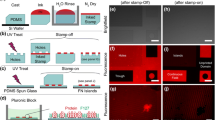Abstract
Polymorphonuclear leukocytes (PMNs) are responsible for much of the first wave of leukocyte-mediated host defense against microbial pathogens. In order to migrate through the endothelium of vessel walls, undergo chemotaxis, and phagocytize microbes, PMNs must modulate their cytoskeletal elements and undergo change of cellular shape. We have used fluorescence flow cytometric analysis and cellular microscopic observations to demonstrate actin polymerization in bovine PMNs and to examine the kinetics of PMN actin polymerization utilizing different PMN stimuli. In addition, we compared temporal relationships between cellular shape and actin polymerization. Actin polymerization occurred rapidly, and the kinetics of actin polymerization were similar for each of the three PMN agonists used, ZAS (10%), PAF (10−6 M), and rhC5a (10−7 M). Actin polymerization was near-maximal by 10 sec poststimulation (95.4% of maximal F-actin content attained by 10 sec poststimulation with ZAS stimulation), and reached peak values by 30 sec. The maximal increase in F-actin content of agonist-stimulated cells as compared to resting cells was 2.8-fold with ZAS; 2.3-fold with PAF; and 2.3-fold with rhC5a. PMN shape change (pseudopodia, membrane raffles) was not as rapid, with only 22.4% of cells attaining visible membrane deformation by 10 sec and requiring 120 sec to reach peak shape-change values. After attaining peak values, the two events also differed. Whereas the percent of shape-changed PMNs remained plateaued up to 5 min poststimulation, the F-actin content gradually decreased after 30 sec, approaching F-actin values of unstimulated PMNs.
Similar content being viewed by others
References
Sawyer, D. W., G. R. Donowitz, andG. L. Mandell. 1989. Polymorphonuclear neutrophils: An effective antimicrobial force.Rev. Infect. Dis. 11(Suppl. 7):S1532-S1544.
Colditz, I. G., R. L. Kerlin, andD. L. Watson. 1988. Migration of neutrophils and their role in elaboration of host defense.In Migration and Homing of Lymphoid Cells. A. J. Husband, editor. CRC Press, Boca Raton, Florida. 135–165.
Ferrante, A., M. Nandoskar, A. Walz, D. H. B. Goh, andI. C. Kowanko. 1988. Effects of tumor necrosis factor alpha and interleukin-1 alpha and beta on human neutrophil migration, respiratory burst and degranulation.Int. Arch. Allergy Appl. Immunol. 86:82–91.
Webster, R. O., S. R. Hong, R. B. Johnston Jr., andP. M. Henson. 1980. Biologic effects of the human complement fragments C5a and C5adesArg on neutrophil function.Immunopharmacology 2:201–219.
Van Kessel, K. P. M., andJ. Verhoef. 1990. A view to a kill: Cytotoxic mechanisms of human polymorphonuclear leukocytes compared with monocytes and natural killer cells.Pathobiology 58:249–264.
Packman, C. H., andM. A. Lichtman. 1990. Activation of neutrophils: Measurement of actin conformational changes by flow cytometry.Blood Cells 16:193–207.
Stossel, T. P. 1989. From signal to pseudopod. How cells control cytoplasmic actin assembly.J. Biol. Chem. 264:18261–18264.
Howard, T. H., andW. H. Meyer. 1984. Chemotactic peptide modulation of actin assembly and locomotion in neutrophils.J. Cell Biol. 98:1265–1271.
Korn, E. D. 1982. Actin polymerization and its regulation by proteins from nonmuscle cells.Physiol. Rev. 62:672–737.
Wallace, P. J., R. P. Wersto, C. H. Packman, andM. A. Lichtman. 1984. Chemotactic peptide-induced changes in neutrophil actin conformation.J. Cell Biol. 99:1060–1065.
Holden, W., D. O. Slauson, R. D. ZWAhlen, M. M. Suyemoto, M. Dore, andN. R. Neilsen. 1989. Alterations in complement-induced shape change and stimulus-specific superoxide anion generation by neonatal calf neutrophils.Inflammation 13:607–620.
Clifford, C. B., D. O. Slauson, N. R. Neilsen, M. M. Suyemoto, R. D. Zwahlen, andD. H. Schlafer. 1989. Ontogeny of inflammatory cell responsiveness: Superoxide anion generation by phorbol ester-stimulated fetal, neonatal, and adult bovine neutrophils.Inflammation 13:221–231.
Dore, M., D. O. Slauson, M. M. Suyemoto, andN. R. Neilsen. 1990. Calcium mobilization in C5a-stimulated adult and newborn bovine neutrophils.Inflammation 14:71–82.
Hammerschmidt, D. E., T. K. Bowers, C. J. Lammi-Keefe, H. S. Jacob, andP. R. CradDock. 1980. Granulocyte aggregometry: A sensitive technique for the detection of C5a and complement activation.Blood 55:898–902.
Slauson, D. O., D. S. Skrabalak, N. R. Neilsen, andR. D. Zwahlen. 1987. Complementinduced equine neutrophil adhesiveness and aggregation.Vet. Pathol. 24:239–249.
Howard, T. H., andC. O. Oresajo. 1985. The kinetics of chemotactic peptide-induced change in F-actin content, F-actin distribution, and the shape of neutrophils.J. Cell Biol. 101:1078–1085.
Howard, T., C. Chaponnier, H. Yin, andT. Stossel. 1990. Gelsolin-actin interaction and actin polymerization in human neutrophils.J. Cell Biol. 110:1983–1991.
Wymann, M. P., P. Kernen, T. Bengtsson, T. Andersson, M. Baggiolini, andD. A. Deranleau. 1990. Corresponding oscillations in neutrophil shape and filamentous actin content.J. Biol. Chem. 265:619–622.
Wang, D. H., K. Berry, andT. H. Howard. 1990. Kinetic analysis of chemotactic peptideinduced actin polymerization in neutrophils.Cell Motil. Cytoskeleton 16:80–87.
Niggli, V., andH. Keller. 1991. On the role of protein kinases in regulating neutrophil actin association with the cytoskeleton.J. Biol. Chem. 266:7927–7932.
Bengtsson, T., T. Stendahl, andT. Andersson. 1986. The role of cytosolic free calcium transient for fMet-Leu-Phe induced actin polymerization in human neutrophils.Eur. J. Cell Biol. 42:338–343.
Bengtsson, T., E. Sarndahl, Biol. Stendahl, andT. Andersson. 1990. Involvement of GTPbinding proteins in actin polymerization in human neutrophils.Proc. Natl. Acad. Sci. U.S.A. 87:2921–2925.
Watts, R. G., M. A. Crispens, andT. H. Howard. 1991. A quantitative study of the role of F-actin in producing neutrophil shape.Cell. Motil. Cytoskeleton 19:159–168.
Hilmo, A., andT. H. Howard. 1987. F-actin content of neonate and adult neutrophils.Blood 69:945–949.
Sacchi, F., N. H. Augustine, M. M. Coello, E. Z. Morris, andH. R. Hill. 1987. Abnormality in actin polymerization associated with defective chemotaxis in neutrophils from neonates.Int. Arch. Allergy Appl. Immunol. 84:32–39.
Southwick, F. S., G. A. Dabiri, andT. P. Stossel. 1988. Neutrophil actin dysfunction is a genetic disorder associated with partial impairment of neutrophil actin assembly in three family members.J. Clin. Invest. 82:1525–1531.
Author information
Authors and Affiliations
Rights and permissions
About this article
Cite this article
Bochsler, P.N., Neilsen, N.R., Dean, D.F. et al. Stimulus-dependent actin polymerization in bovine neutrophils. Inflammation 16, 383–392 (1992). https://doi.org/10.1007/BF00917629
Issue Date:
DOI: https://doi.org/10.1007/BF00917629




